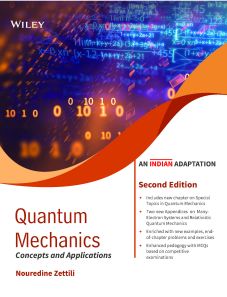Quantum Mechanics, 2ed: Concepts and Applications (An Indian Adaptation)
ISBN: 9789354640773
852 pages
For more information write to us at: acadmktg@wiley.com

Description
Quantum Mechanics: Concepts and Applications provides a clear, balanced, and modern introduction to the subject and is an authoritative text for senior undergraduate and graduate courses. The book takes an innovative approach to quantum mechanics by combining the essential elements of the theory with the practical applications. It starts with the experimental basis of quantum mechanics and then discusses its mathematical tools.
1.1 Historical Note
1.2 Particle Aspect of Radiation
1.3 Wave Aspect of Particles
1.4 Particles versus Waves
1.5 Indeterministic Nature of the Microphysical World
1.6 Quantization Rules
1.7 Fourier Transform and Wave Packets
1.8 Concluding Remarks
1.9 Solved Problems
1.10 Exercises
1.11 Multiple-Choice Questions
2 Mathematical Tools of Quantum Mechanics
2.1 Introduction
2.2 The Hilbert Space and Wave Functions
2.3 Dirac Notation
2.4 Operators
2.5 Representation in Discrete Bases
2.6 Representation in Continuous Bases
2.7 Matrix and Wave Mechanics
2.8 The Dirac-Delta Function
2.9 Concluding Remarks
2.10 Solved Problems
2.11 Exercises
2.12 Multiple-Choice Questions
3 Postulates of Quantum Mechanics
3.1 Introduction
3.2 The Basic Postulates of Quantum Mechanics
3.3 The State of a System
3.4 Observables and Operators
3.5 Measurement in Quantum Mechanics
3.6 Time Evolution of the System’s State
3.7 Symmetries and Conservation Laws
3.8 Connecting Quantum to Classical Mechanics
3.9 Solved Problems
3.10 Exercises
3.11 Multiple-Choice Questions
4 One-Dimensional Problems
4.1 Introduction
4.2 Properties of One-Dimensional Motion
4.3 The Free Particle: Continuous States
4.4 The Potential Step
4.5 The Potential Barrier and Well
4.6 The Infinite Square Well Potential
4.7 The Finite Square Well Potential
4.8 The Harmonic Oscillator
4.9 Solved Problems
4.10 Exercises
4.11 Multiple-Choice Questions
5 Angular Momentum
5.1 Introduction
5.2 Orbital Angular Momentum
5.3 Eigenfunctions of Orbital Angular Momentum
5.4 General Formalism of Angular Momentum
5.5 Spin Angular Momentum
5.6 Matrix Representation of Angular Momentum
5.7 Solved Problems
5.8 Exercises
5.9 Multiple-Choice Questions
6 Three-Dimensional Problems
6.1 Introduction
6.2 3D Problems in Cartesian Coordinates
6.3 3D Problems in Spherical Coordinates
6.4 Concluding Remarks
6.5 Solved Problems
6.6 Exercises
6.7 Multiple-Choice Questions
7 Rotations and Addition of Angular Momenta
7.1 Rotations in Classical Physics
7.2 Rotations in Quantum Mechanics
7.3 Addition of Angular Momenta
7.4 Scalar, Vector, and Tensor Operators
7.5 Solved Problems
7.6 Exercises
7.7 Multiple-Choice Questions
8 Identical Particles
8.1 Many-Particle Systems
8.2 Systems of Identical Particles
8.3 The Pauli Exclusion Principle
8.4 The Exclusion Principle and the Periodic Table
8.5 Solved Problems
8.6 Exercises
8.7 Multiple-Choice Questions
9 Approximation Methods for Stationary States
9.1 Introduction
9.2 Time-Independent Perturbation Theory
9.3 The Variational Method
9.4 The Wentzel–Kramers–Brillouin Method
9.5 Concluding Remarks
9.6 Solved Problems
9.7 Exercises
9.8 Multiple-Choice Questions
10 Time-Dependent Perturbation Theory
10.1 Introduction
10.2 The Pictures of Quantum Mechanics
10.3 Time-Dependent Perturbation Theory
10.4 Adiabatic and Sudden Approximations
10.5 Interaction of Atoms with Radiation
10.6 Solved Problems
10.7 Exercises
10.8 Multiple-Choice Questions
11 Scattering Theory
11.1 Scattering and Cross Section
11.2 Scattering Amplitude of Spinless Particles
11.3 The Born Approximation
11.4 Partial Wave Analysis
11.5 Scattering of Identical Particles
11.6 Solved Problems
11.7 Exercises
11.8 Multiple-Choice Questions
12 Special Topics in Quantum Mechanics
12.1 Foundations of Quantum Mechanics
12.2 Quantum Computation
12.3 Solved Problems
12.4 Exercises
Appendix A Angular Momentum: Spherical Coordinates, Rotations, Addition and Isospin
A.1 Derivation of Some General Relations
A.2 Gradient and Laplacian in Spherical Coordinates
A.3 Angular Momentum in Spherical Coordinates
A.4 Euler Rotations
A.5 Representation of the Rotation Operator
A.6 Rotation Matrices and the Spherical Harmonics
A.7 Addition of More Than Two Angular Momenta
A.8 Rotation Matrices for Coupling Two Angular Momenta
A.9 Isospin
Appendix B Solving the Schrödinger Equation—Numerical Solution, C++ And Python Code
B.1 Numerical Solution of the Schrödinger Equation
B.2 C++ Code for Solving the Schrödinger Equation
B.3 Exploring The Schrödinger Equation with Python
Appendix C Many-Electron Systems
C.1 Born−Oppenheimer Approximation
C.2 Hartree–Fock Theory
C.3 A Brief Introduction to Density Functional Theory
Appendix D Relativistic Quantum Mechanics
D.1 Klein–Gordon Equation
D.2 Dirac Equation
D.3 Fields and their Quantization
Index

